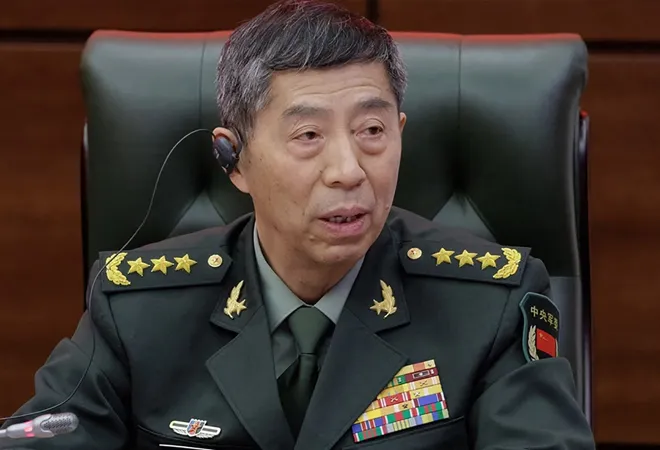
As Chinese Defence Minister, General Li Shangfu, visits India to attend the Shanghai Cooperation Organisation (SCO) Defence Ministers’ meeting, the Chinese discourse on India remains largely pessimistic, with
some even resenting what they see as “India manipulating its presidency to bring China-India border conflict into the ambit of the SCO,” and “to provide evidence (written evidence and satellite images) of PLA incursions at the LAC to the Chinese side as well as others, so as to portray itself as a victim and
slander China at a multilateral forum.”
In fact, it is argued that China has already taken a series of escalatory measures in the last few days to guard against India’s “
capriciousness” and stabilise the Southwest frontier. These steps include hyping up the China-Bhutan border dialogue,
renaming places within Arunachal Pradesh, and freezing Indian
journalists’ visas, amongst others. Of these, the move that is most
discussed and
lauded in the Chinese media (but not covered as much in the Indian/international media) is about how, on April 3—a few days after the Prime Minister of Bhutan issued a controversial statement and the Chinese authorities published a map of newly “standardised” place names within Arunachal Pradesh—the government of the Tibet Autonomous Region issued an announcement to upgrade two Tibetan border towns along the LAC—Milin and Cuona—into city-states and to take them under the direct administration of the
regional government. Not just that, the seat of the city government for Cuona City was also moved from the original Cuona Town to what China calls
Mama Menba Ethnic Township (Mama Township) in Lebugou border region.
The seat of the city government for Cuona City was also moved from the original Cuona Town to what China calls Mama Menba Ethnic Township (Mama Township) in Lebugou border region.
In the Chinese assessment, the move is of great
strategic significance as the two newly established cities of Milin and Cuona are divided by the McMahon Line, “with some amount of land of the Milin City lying with India, while nearly
two-thirds of the city of Cuona being actually controlled by India”. Meanwhile, the Mama Township, where the city government of the Cuona City has been moved, is very close to the LAC and borders Bhutan on the west. This was the front line of the People’s Liberation Army fighting in Lebugou during the
1962 China-India war. It was also the location of the command post of the PLA at that time. The
Tawang area and the Xishankou Pass are close to the Mama Township. Some Chinese strategists think that the move is similar to China's establishment of
Sansha City in the South China Sea and that the Chinese government is now keen to replicate its successful experience in the South China Sea (of reclamation and island construction, strengthening of infrastructure construction and upgradation of administrative division etc.) in the “Southern Tibet” dispute as well. In the Chinese assessment, the move will kill
three birds with one stone.
First, it aims to enhance the
actual control and management over the eastern section of the Sino-Indian border and strengthen China’s
sovereignty claims over Arunachal Pradesh. The mandate now is to carry out urban construction; large-scale infrastructure construction in these newly established cities, including
airports and roads; develop the capability to control important mountains, rivers, and mountain passes in the region; and ensure a steady
influx of people in these sparsely populated areas. The idea is to use these cities in the
future struggle against India, making them serve as “
horns”, following similar military functions. Meanwhile, in comparatively peaceful times, these can be used to carry out China’s long-held ambition of pursuing
economic exchanges with Bhutan and utilising Bhutan’s privileged access to the Indian market, to open up the economic hinterland of India for its own land-locked western provinces.
Second, by doubling down on its claims on the Arunachal Pradesh, China wants to warn India against seeking profit from deteriorating Sino-United States (US) ties, including obtaining “greater benefits” on the Sino-Indian border issue. Referring to Foreign Minister S Jaishankar’s speech on 18
March and Army Chief of Staff Manoj Pande’s speech on 29
March, various Chinese observers are of the opinion that India has so far had little appreciation for the Chinese initiative to hold more than ten rounds of military commander-level border talks, and that India is unwilling to end the dispute on Chinese terms, thereby, depriving China’s southwestern border of a
moment of peace. Instead, they say, India is
catering to the interests of the US and the West, trying to
fish in troubled waters and, using the US-China conflict to fuel its rise (just as the
US war against North Korea led to the rise of Japan, and the US war against Vietnam allowed South Korea to create an economic miracle). Thus, by raking up the Arunachal issue and conveying the message that China can actually control this region, it wants to pressurise India to soften its stance vis-à-vis China.
These can be used to carry out China’s long-held ambition of pursuing economic exchanges with Bhutan and utilising Bhutan’s privileged access to the Indian market, to open up the economic hinterland of India for its own land-locked western provinces.
The
third is to convey to the international community, particularly the US, that the McMahon Line is “illegal and invalid” and should not be recognised. On 14
March, the US bipartisan Senate passed a resolution stating that the "McMahon Line" is the international boundary between China and Arunachal Pradesh and that it is an indivisible part of India. Most Chinese observers are of the opinion that China’s current move in the eastern sector of the LAC is a direct response to this “
provocative stance” taken by the US. The other recent development that also caused quite an alarm within the Chinese strategic community and generated much discussion online was about the possible US role in the Sino-Indian border conflict as seen on 9
December 2022, especially the intelligence-sharing arrangement between the two countries, as part of the basic exchange and cooperation agreement for geospatial cooperation (
BECA) signed in 2020. The key concern, as is evident from the writings of the Chinese observers, is that if the
intelligence-gathering capabilities of the Americans, which is supposed to be the world’s best, are combined with the mountain combat capabilities of the Indian army, one of the largest and most competent forces globally, it may pose a major threat to PLA
border patrols at the disputed China-India border. Apart from intelligence-sharing, there are also
concerns about the possibility of more high-end weapons being made available to India by the US in the future, more high-profile military exercises near the Sino-Indian border—all of which are considered detrimental to Chinese interests. This is largely because these actions can actually curb the so-far steady momentum of China’s rise in the Asia-Pacific region to a certain extent. Therefore, the
inference drawn by China in this regard, as per Zhang Jiadong, Professor at the Fudan University, is that, earlier, the US has never intervened in the Sino-India border dispute but now that the relationship between China and the US has soured, it is openly taking sides, by standing
in line with India while containing China. The idea, it is argued, is to make India more
confident to face China, "
ignite a fire” between the two Asian giants, while reaping the “fisherman’s benefit” from the situation.
If the intelligence-gathering capabilities of the Americans, which is supposed to be the world’s best, are combined with the mountain combat capabilities of the Indian army, one of the largest and most competent forces globally, it may pose a major threat to PLA border patrols at the disputed China-India border.
Overall, looking at the current Chinese discourse on India, it becomes quite evident that one of the key reasons behind China reaching out to India—through high-level visits hyping up the narrative that “the border issue is shifting from a standoff to
normalized management” or through carrying out “combination strikes (
组合拳)” against India at the eastern sector of the LAC—is triggered by its deepening concern over the convergence of interest between the US and India. An oft-repeated view in this regard is that, so far,
the competition between China and the US is in a balanced state, where no one side is at an absolute advantage or absolute disadvantage. However, if India
intervenes in the competition between China and the US, it may upset this delicate balance in the favour of the latter. For instance, the differences between China and the US are mainly concentrated in the South China Sea and the Taiwan Strait, which they claim China is currently handling with ease. However, if the situation simultaneously deteriorates in the South China Sea or the Taiwan Strait, and the Southwest frontier also remains unstable, it is hard to say whether China can cope with the situation with as much ease. The dilemma remains on how to deal with a “difficult opponent” like India, where China doesn’t have to accommodate its (India's) demands at the LAC (particularly the demand for reversion to pre-April 2020 positions), but also not cause further deterioration in bilateral ties, thereby making China fall into the predicament of two-front conflict. This is the key question in the mind of the Chinese strategic community, as its defence minister holds bilateral talks with his Indian counterpart Rajnath Singh.
Antara Ghosal Singh is a Fellow at the Strategic Studies Programme, Observer Research Foundation
The views expressed above belong to the author(s). ORF research and analyses now available on Telegram! Click here to access our curated content — blogs, longforms and interviews.



 As Chinese Defence Minister, General Li Shangfu, visits India to attend the Shanghai Cooperation Organisation (SCO) Defence Ministers’ meeting, the Chinese discourse on India remains largely pessimistic, with
As Chinese Defence Minister, General Li Shangfu, visits India to attend the Shanghai Cooperation Organisation (SCO) Defence Ministers’ meeting, the Chinese discourse on India remains largely pessimistic, with  PREV
PREV


